Genre: Action Developer: Tiertex Publisher: U.S. Gold Players: 1 Released: 1991
Strider Hiryu is considered by some to be one of the greatest video game heroes ever. Since his first appearance in 1989 in arcades, the legend behind him has grown. Strider games have appeared on many consoles over the years, to varying degrees of success. Hiryu himself has made appearances in many of Capcom’s other games, most notably the Marvel vs. Capcom series and the Japanese-only release Namco X Capcom.
However, in the early ’90s, Capcom had licensed the original Strider arcade game, along with the Strider name and Capcom-created characters, to the publishing house U.S. Gold. They proceeded to turn out a number of ports of the original arcade game for the various PC platforms at the time. Then, working with the company Tiertex, they created Journey From Darkness: Strider Returns (hereafter referred to as JFD), which was intended to be a sequel to the arcade game, as evidenced by the “Strider II” title given to the game in Europe.
According to the story, Grand Master Meio has returned and kidnapped Lexia, whoever she is. Most likely because U.S. Gold didn’t (or couldn’t) get the rights to the character of Hiryu from Motomiya Kikaku (the entity that owns the Hiryu character), you’re now playing as Strider Hinjo, who’s just a palette-swapped Hiryu sprite from the Genesis port of the Strider arcade game. Anyway, name changes aside, you have to defeat Meio and get Lexia back.
On first inspection, it seems that the designers ripped a few characters and pictures out of the Genesis port of Strider, changed the color of Hiryu’s outfit, and dropped everything into one of the many mediocre Amiga games I used to play back in high school. Graphically, it’s unimpressive. The backgrounds are muddy and nondescript, the enemies and other characters are generic and unimaginative, and the level designs don’t have a tenth of the originality the original game did. In fact, virtually all of the great visual aspects of the original Strider are gone. All of the power-up icons from the original have been changed as well, and not for the better: for example, instead of the sword power icon from the original, there’s now a little black box that says “Power Up.”
The controls are for the most part unresponsive. All of Hiryu’s moves from the arcade original are intact, but Hinjo moves so slowly it’s like playing the Sega Master System version of Strider, which was known for its slow-motion Hiryu. Hinjo does have a new weapon to try to make up for this deficiency, throwing stars, but he can’t fire them fast enough to take out most of the faster enemies. You also have a choice between the original Cypher (Hinjo’s main weapon) and a new Sweep Sword, which has a longer range than the Cypher. Out of the two, the original Cypher seems to work a lot better. The Sweep Sword misses enemies half the time, despite its range. To make things worse, the difficulty curve is really steep. The hit detection is almost nonexistent and it’s very easy to die. On top of that you only get five continues, and those can go pretty quick.
Most of the little extras from the original game are gone. The Hawk Robot and the Teropodal Robo-Panther are missing, and the Drone that you get is now a small black sphere. You can still power-up your Cypher. Unlike the original, when you die, you keep your power-up. If you happen to pick up another power-up while you have a powered-up Cypher, you’ll receive seven throwing stars. There are also reserve energy tanks for filling your life bar back up. Another addition to Hinjo’s arsenal is a separate energy bar, which you can fill up by picking up icons resembling oil cans. These give you defensive orbs that protect you when you’re fighting the stage boss.
The music is passable, but the sound effects are terrible, mostly consisting of bland explosion sounds and other random effects. JFD also contains voice samples, which are completely laughable. The strange thing about this is when trying the game out on an emulator, the voices sound pretty good. Yet coming from an actual cart being played on a Genesis system, Hinjo and Grand Master Meio sound like chipmunks. This may have had to do with the switch from PAL to NTSC, as JFD was programmed in Europe for the PAL Mega Drive, then brought to the US.
All of this brought together into one package makes for a completely bland, unresponsive and frustrating would-be successor to a fantastic, imaginative, compelling and legendary arcade classic. To add insult to injury, the opening story in the instruction book looks like it was written by clueless marketing executives that thought they knew what the latest “hip” and “street” slang was.
In the end, Journey From Darkness: Strider Returns turned out to be a lame attempt to cash in on a then-popular character that was still riding the wave of popularity generated by the fantastic Genesis port of the original arcade game. Capcom did nothing with Strider for a few years – although that may have been because it was right in the middle of Street Fighter II-mania at the time – until Hiryu resurfaced in Marvel vs. Capcom. His return paved the way for a true Strider resurrection, the Capcom-developed Strider 2, which was released in arcades in 1999 and on the Sony PlayStation in 2000. If you need a Strider fix, I highly recommend tracking the PlayStation port down. Not only do you get the real Strider 2, you also get the original Strider arcade game. If you still want more Strider, go out and track down a copy of Run Saber (SNES) or look up Osman/Cannon Dancer on MAME before you get this. Both of those may not be real Strider games, but they’re both more like the original Strider than Tiertex’s abortion of a game is.
SCORE: 3 out of 10

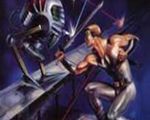
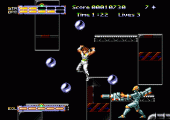
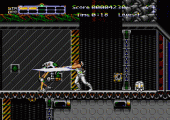
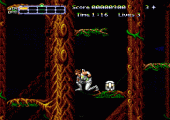
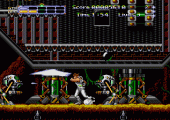
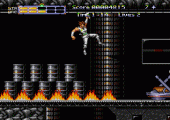
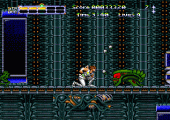
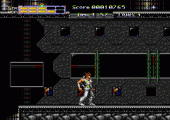
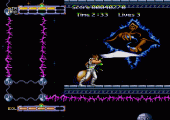
Recent Comments